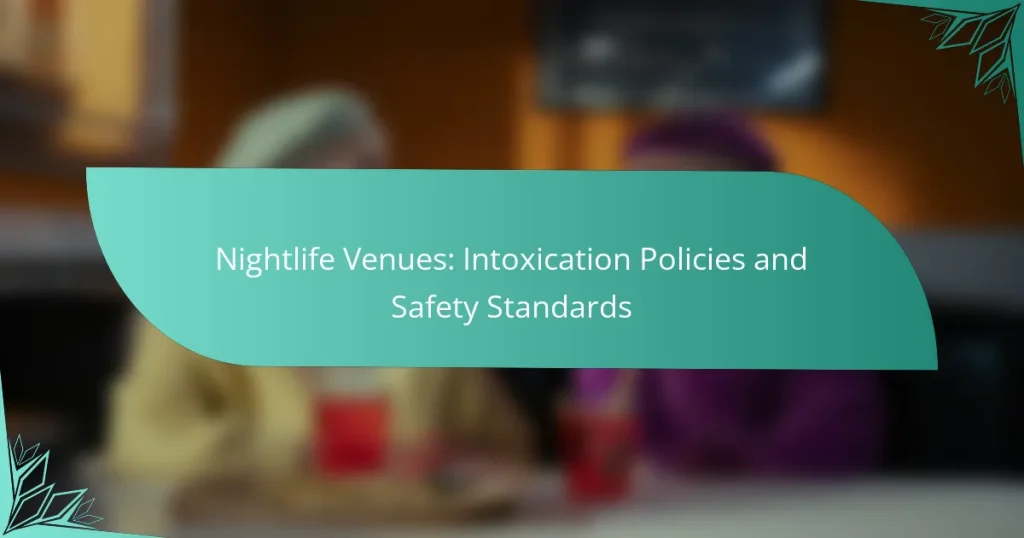Nightlife venues across major cities like New York and Los Angeles prioritize safety through strict intoxication policies and comprehensive safety standards. These measures include monitoring alcohol consumption, refusing service to intoxicated individuals, and implementing emergency protocols to ensure a secure environment for all patrons. Adhering to these policies not only protects the well-being of guests but also helps venues avoid legal repercussions and maintain compliance with local regulations.

What are the intoxication policies in nightlife venues in New York City?
In New York City, nightlife venues implement strict intoxication policies to promote safety and responsible drinking. These policies typically include monitoring patrons’ alcohol consumption, refusing service to visibly intoxicated individuals, and adhering to legal blood alcohol concentration limits.
Standard operating procedures
Nightlife venues in New York City follow standard operating procedures to manage intoxication effectively. These procedures often involve training staff to recognize signs of intoxication and to intervene when necessary. Venues may also establish a protocol for handling intoxicated patrons, which can include offering water, food, or arranging safe transportation home.
Additionally, many establishments utilize a system to track drink orders, ensuring that bartenders and servers are aware of how much alcohol a patron has consumed. This helps in making informed decisions about serving more drinks.
Legal blood alcohol concentration limits
The legal blood alcohol concentration (BAC) limit for driving in New York is 0.08%. Nightlife venues are responsible for ensuring that patrons do not reach this level while on their premises. While there is no specific BAC limit for remaining in a bar or club, establishments must refuse service to anyone who appears intoxicated, which may be indicated by behavior or physical signs.
Venues may also implement their own internal limits to further promote safety, often aiming for a BAC of 0.05% or lower for patrons who are still being served. This proactive approach helps reduce the risk of alcohol-related incidents.
Training requirements for staff
Staff training is crucial for enforcing intoxication policies in nightlife venues. In New York City, many establishments require their employees to undergo training programs such as the New York State Alcohol Training Awareness Program (ATAP). These programs educate staff on recognizing signs of intoxication and the legal responsibilities associated with serving alcohol.
Regular refresher courses are also recommended to keep staff updated on best practices and legal changes. By ensuring that employees are well-trained, venues can better manage intoxication and enhance overall patron safety.

How do nightlife venues ensure safety standards in Los Angeles?
Nightlife venues in Los Angeles implement various safety standards to protect patrons and staff, focusing on emergency protocols, trained security personnel, and surveillance systems. These measures are designed to create a secure environment while complying with local regulations and industry best practices.
Emergency response protocols
Emergency response protocols in Los Angeles nightlife venues are essential for handling incidents such as medical emergencies or violent altercations. Venues typically establish clear procedures that include immediate communication with local authorities and designated staff roles during emergencies.
Regular drills and training sessions help ensure that staff are familiar with these protocols. Venues may also post emergency exit routes and contact information for emergency services prominently throughout the premises.
Security personnel training
Security personnel in nightlife venues undergo specialized training to effectively manage crowd control and ensure patron safety. This training often includes conflict resolution, first aid, and understanding local laws regarding alcohol service and public safety.
Many venues require security staff to complete certification programs that cover topics such as recognizing signs of intoxication and de-escalation techniques. This preparation helps create a safer environment for everyone in the venue.
Surveillance system requirements
Surveillance systems in Los Angeles nightlife venues are crucial for monitoring activities and ensuring safety. Venues are typically equipped with high-definition cameras placed strategically to cover entrances, exits, and key areas within the establishment.
Compliance with local regulations often dictates the number and placement of cameras. Additionally, venues may retain footage for a specified period to assist law enforcement if incidents occur, enhancing overall security and accountability.
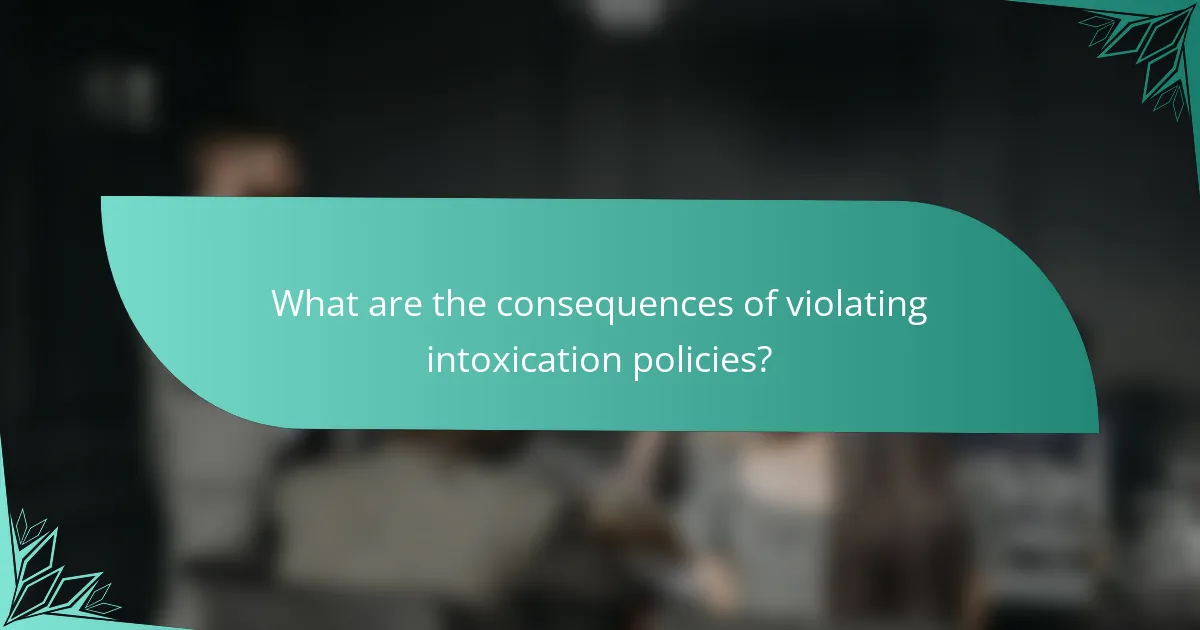
What are the consequences of violating intoxication policies?
Violating intoxication policies can lead to significant consequences for both venues and patrons. Venues may face fines and penalties, while patrons could encounter legal repercussions, including arrest or charges related to public intoxication.
Fines and penalties for venues
Venues that fail to adhere to intoxication policies may incur fines ranging from hundreds to thousands of dollars, depending on the severity of the violation and local regulations. Repeat offenders often face increased penalties, which can include temporary or permanent loss of their liquor license.
In addition to monetary fines, venues may also be subjected to increased scrutiny from regulatory bodies. This can lead to more frequent inspections and a requirement to implement additional training for staff regarding responsible service of alcohol.
Legal repercussions for patrons
Patrons who violate intoxication policies may face legal consequences such as fines, community service, or even arrest for public intoxication. The severity of these repercussions often depends on the individual’s behavior and the specific laws in their jurisdiction.
In some cases, patrons may also be banned from returning to the venue or face restrictions on their ability to enter other establishments. It’s essential for individuals to understand local laws regarding alcohol consumption to avoid potential legal issues.
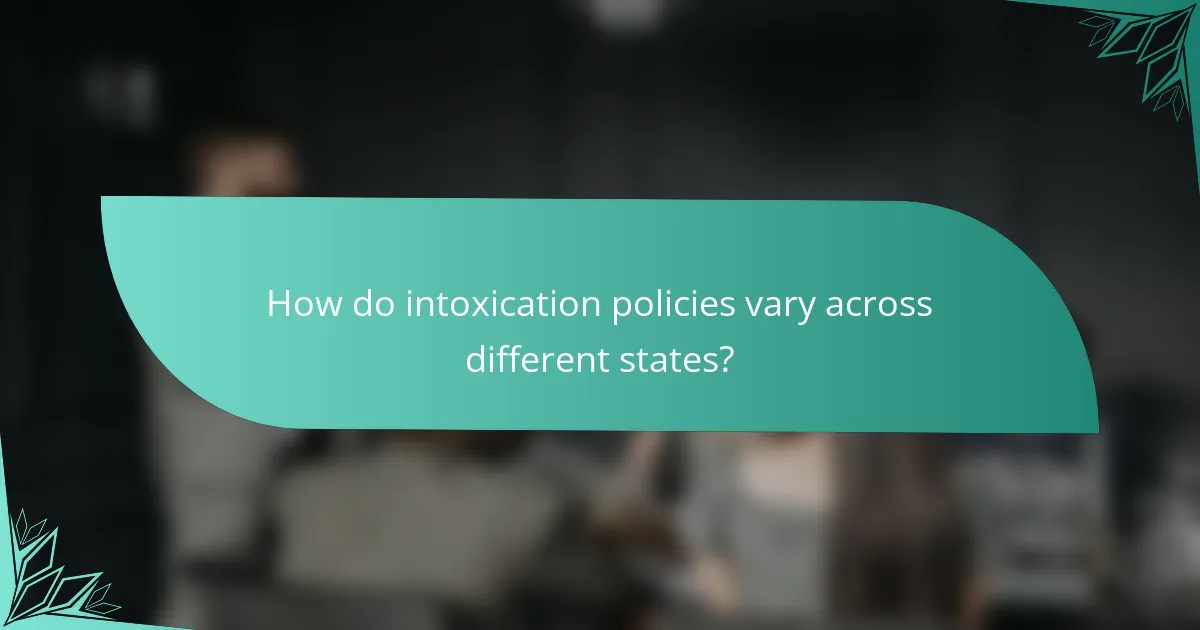
How do intoxication policies vary across different states?
Intoxication policies differ significantly across states, reflecting local laws and cultural attitudes towards alcohol consumption. These regulations dictate how venues manage intoxicated patrons and the responsibilities they hold in ensuring safety.
State-specific regulations
Each state has its own set of laws governing the service of alcohol and the management of intoxicated individuals. For instance, some states require establishments to implement specific training programs for staff on recognizing signs of intoxication, while others may have stricter penalties for serving alcohol to visibly intoxicated patrons. In states like California, the law mandates that servers must refuse service to anyone who appears intoxicated, whereas in Texas, the focus is more on the establishment’s liability in case of incidents involving intoxicated customers.
Additionally, states may vary in their approaches to ID checks and the enforcement of age restrictions. In some areas, venues are required to scan IDs to verify age, while others may allow more discretion in checking identification.
Comparative analysis of policies
A comparative analysis reveals that states with stricter intoxication policies often have lower rates of alcohol-related incidents. For example, states like New York and Massachusetts emphasize responsible serving practices, which can lead to a safer nightlife environment. In contrast, states with more lenient policies may experience higher instances of over-serving and related accidents.
Moreover, the consequences for violating intoxication policies can vary widely. Some states impose hefty fines and potential license suspensions for establishments that fail to comply, while others may only issue warnings. This disparity can influence how nightlife venues develop their own internal policies regarding intoxication management.
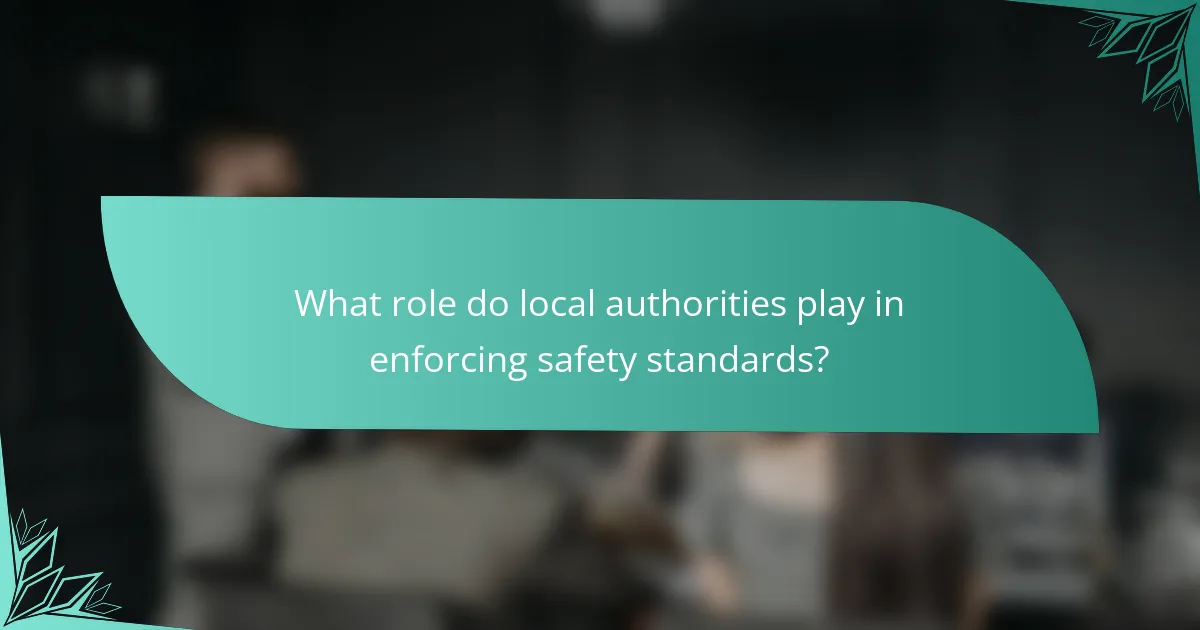
What role do local authorities play in enforcing safety standards?
Local authorities are crucial in enforcing safety standards for nightlife venues, ensuring compliance with regulations that protect patrons and staff. They implement licensing requirements, conduct inspections, and enforce compliance checks to maintain a safe environment.
Licensing requirements
Licensing requirements for nightlife venues vary by location but generally include obtaining a license to serve alcohol, adhering to occupancy limits, and ensuring proper safety measures are in place. Venues must submit detailed plans that outline their operational procedures, including emergency exits and crowd management strategies.
For example, in many jurisdictions, venues must renew their licenses annually and may be subject to fees that can range from a few hundred to several thousand dollars, depending on the size and type of establishment. Failure to comply can result in fines or revocation of the license.
Inspections and compliance checks
Local authorities conduct regular inspections and compliance checks to ensure nightlife venues adhere to safety standards. These inspections typically assess fire safety measures, sanitation, and crowd control practices, often occurring randomly or following complaints.
Venues can expect inspections at least once a year, but high-traffic locations may face more frequent visits. Establishments found in violation may be given a grace period to rectify issues, but repeated violations can lead to significant penalties, including closure.
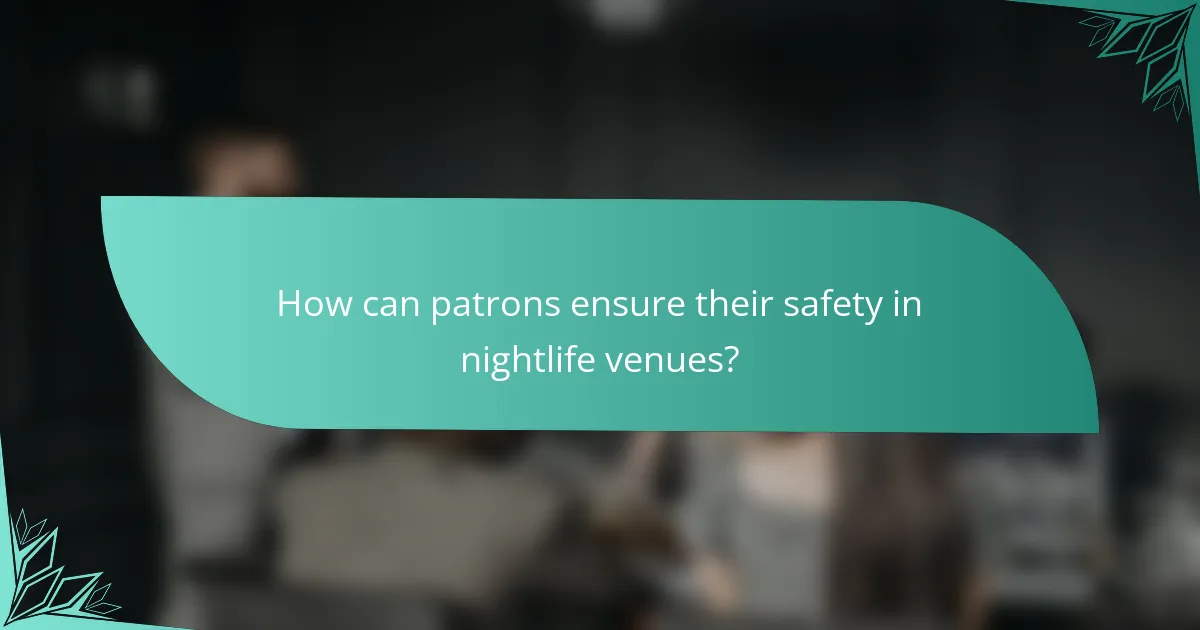
How can patrons ensure their safety in nightlife venues?
Patrons can enhance their safety in nightlife venues by being aware of venue policies and implementing strategies for safe transportation. Understanding the rules and having a plan for getting home can significantly reduce risks associated with intoxication and unsafe environments.
Awareness of venue policies
Each nightlife venue has its own set of policies regarding intoxication, entry, and behavior. Familiarizing yourself with these rules can help you navigate the environment safely. For example, some venues may have a strict policy on serving alcohol to visibly intoxicated patrons, while others may enforce a dress code or age restrictions.
Check for any posted signs or ask staff about their policies on intoxication and safety measures. Knowing the venue’s emergency procedures, such as exits and first aid locations, can also be beneficial in case of an incident.
Strategies for safe transportation
Planning your transportation in advance is crucial for ensuring a safe night out. Consider using rideshare services, public transportation, or designated drivers to avoid the risks of driving under the influence. Always have a backup plan in case your initial transportation option falls through.
When using rideshare services, verify the driver’s identity and vehicle before getting in. If you are using public transport, check the schedule and routes ahead of time to avoid being stranded late at night. Additionally, consider traveling in groups, as there is safety in numbers.
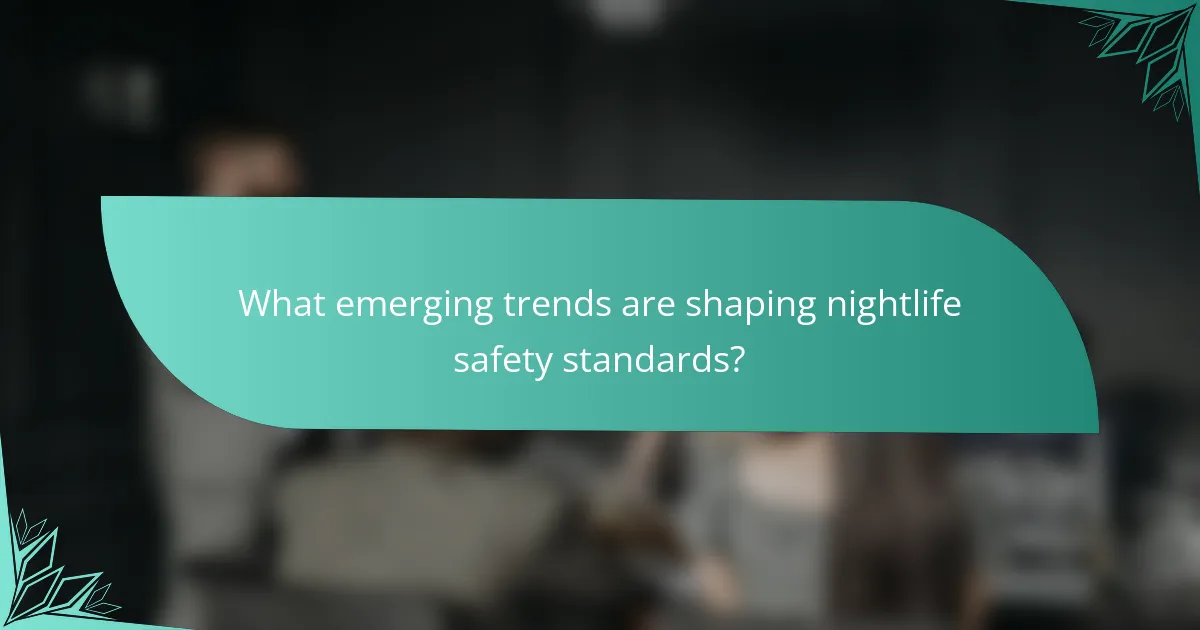
What emerging trends are shaping nightlife safety standards?
Emerging trends in nightlife safety standards focus on integrating technology and fostering community involvement to enhance patron safety. These approaches aim to create a more secure environment while addressing the unique challenges faced by nightlife venues.
Technology integration in monitoring
Nightlife venues are increasingly adopting technology to monitor safety and intoxication levels. Tools such as facial recognition, crowd management software, and real-time incident reporting systems help staff respond quickly to potential issues. For instance, some venues use apps that allow patrons to report concerns discreetly, facilitating faster intervention.
Additionally, wearable technology is gaining traction, with devices that can alert staff if a patron shows signs of distress or excessive intoxication. This proactive approach not only enhances safety but also helps venues comply with local regulations regarding responsible service of alcohol.
Community engagement initiatives
Community engagement initiatives play a crucial role in shaping nightlife safety standards. Venues are collaborating with local law enforcement, health services, and community organizations to develop programs that educate patrons about responsible drinking and personal safety. These partnerships can lead to workshops and events that promote safer nightlife experiences.
Moreover, involving the community in safety discussions fosters a sense of shared responsibility. Venues that actively seek feedback from patrons and local residents can better understand safety concerns and adapt their policies accordingly, ultimately creating a more enjoyable atmosphere for everyone involved.
